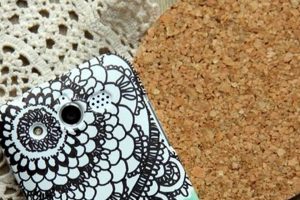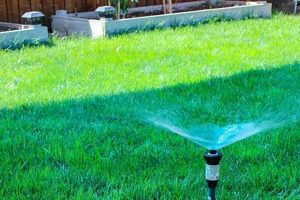A homemade solution designed for cleaning vehicle windshields is formulated using common household ingredients. This mixture serves as a cost-effective alternative to commercially available products, intended to remove dirt, grime, and insects, ensuring clear visibility while driving. A typical example involves combining water, isopropyl alcohol, and a small amount of dish soap.
The value of a self-prepared cleaning agent lies in its affordability and customizability. Individuals can adjust the proportions of ingredients based on seasonal needs or regional climate variations. Historical practices reflect a long-standing tradition of resourcefulness, where individuals sought practical solutions using readily accessible materials. The use of these alternatives reduces reliance on manufactured goods and minimizes plastic container waste associated with commercial products.
The subsequent sections will detail specific recipes, safety precautions, and performance considerations related to creating and utilizing these windshield cleaning solutions. Considerations will also be given to the environmental impact and potential cost savings of adopting this practice.
DIY Windshield Fluid
To ensure optimal performance and safety when utilizing homemade windshield cleaning solutions, adherence to specific guidelines is recommended.
Tip 1: Formulation Accuracy: Precise measurements are crucial. Deviation from established ratios may lead to ineffective cleaning or potential damage to vehicle components.
Tip 2: Isopropyl Alcohol Concentration: The alcohol content should be adjusted based on climate. Higher concentrations are suitable for colder regions to prevent freezing; however, excessive amounts can degrade rubber and plastic.
Tip 3: Dish Soap Dilution: Utilize a minimal amount of dish soap to avoid streaking. An overabundance can create excessive suds, impeding visibility.
Tip 4: Water Quality: Distilled water is preferable. Hard water minerals can leave residue on the windshield, reducing clarity.
Tip 5: System Compatibility: Before widespread use, test the solution on a small, inconspicuous area of the windshield to assess compatibility with existing wiper blades and the vehicle’s washer fluid reservoir materials.
Tip 6: Seasonal Adjustments: Formulations may need alteration based on seasonal conditions. Summer solutions should prioritize insect removal, while winter solutions should focus on de-icing capabilities.
Tip 7: Storage Considerations: Store the prepared solution in a clearly labeled container, away from direct sunlight and extreme temperatures. This prevents degradation and ensures proper identification.
Adherence to these tips will help maximize the effectiveness, safety, and longevity of cleaning with self-prepared windshield washer solutions.
The following section will address troubleshooting common issues and providing alternative solutions.
1. Ingredient Ratios
The efficacy of a homemade cleaning solution is intrinsically linked to the precision of ingredient ratios. These ratios determine the solution’s ability to effectively remove contaminants from the windshield surface without causing damage to vehicle components. An imbalanced formula, for instance, containing excessive dish soap, can leave streaks or a persistent film, impairing visibility and negating the purpose of the cleaning process. Conversely, insufficient concentrations of cleaning agents may prove ineffective against stubborn grime or insect residue, necessitating repeated applications and wasting resources.
Consider the specific example of a solution intended for winter use. The proportion of isopropyl alcohol to water dictates the fluid’s freezing point. An inadequate alcohol concentration renders the solution susceptible to freezing within the reservoir or spray nozzles, potentially causing blockages or even component damage. A properly balanced ratio, guided by regional temperature expectations, ensures consistent functionality in sub-freezing conditions. Furthermore, solutions intended for warmer climates may benefit from a slightly altered ratio to prioritize insect repellent qualities or minimize evaporation rates.
In summary, mastering the manipulation of ingredient ratios is crucial for successful formulation. The interplay of water, alcohol, and cleaning agents dictates not only the immediate cleaning performance but also the long-term integrity of the vehicle’s windshield and associated components. Therefore, meticulous attention to established guidelines and a practical understanding of the chemical properties involved are essential for realizing the full potential of a self-prepared windshield cleaning solution. Ignoring these foundational elements can result in diminished performance, potential damage, and ultimately, a compromise in driving safety.
2. Alcohol Concentration
Alcohol concentration is a critical factor in the formulation of homemade windshield cleaning solutions, impacting its performance across diverse environmental conditions and its compatibility with vehicle components. Understanding the implications of varying alcohol percentages is essential for creating an effective and safe cleaning agent.
- Freezing Point Depression
The primary function of alcohol in a windshield cleaning solution is to lower the freezing point of water. This is particularly crucial in regions experiencing sub-freezing temperatures, as it prevents the solution from solidifying within the reservoir and lines, ensuring continuous operation of the windshield washer system. Insufficient alcohol concentration can lead to system blockages, while excessive amounts, though offering greater freeze protection, may accelerate the degradation of rubber and plastic components.
- Cleaning Performance
While alcohol primarily addresses freezing point, it also contributes to the solution’s cleaning capabilities. Isopropyl alcohol, a common ingredient, acts as a solvent, aiding in the removal of oily residues and road grime from the windshield surface. However, its effectiveness is not linearly proportional to concentration. Above a certain threshold, the cleaning benefit plateaus, and increased alcohol content primarily serves to lower the freezing point, potentially at the cost of material compatibility.
- Material Compatibility
Prolonged exposure to high concentrations of alcohol can negatively impact certain materials commonly used in windshield washer systems, such as rubber hoses, plastic reservoirs, and wiper blades. These materials may become brittle, crack, or degrade over time, leading to leaks or reduced performance. Formulations must strike a balance between freeze protection and material preservation to ensure the longevity of the vehicle’s system.
- Evaporatio
n RateAlcohol’s volatility contributes to the rate at which the cleaning solution evaporates from the windshield surface. A faster evaporation rate can reduce streaking and water spotting, leading to clearer visibility, particularly in warmer climates. However, excessively rapid evaporation may also diminish the solution’s dwell time, potentially reducing its ability to effectively dissolve and remove stubborn contaminants. The ideal evaporation rate is contingent upon environmental conditions and the specific cleaning agent formulation.
In summary, the appropriate alcohol concentration is a carefully considered trade-off. It should be adjusted to match expected temperatures, balanced against potential material degradation, and tailored to achieve the desired cleaning performance. Employing a concentration that exceeds the necessary threshold offers minimal benefit while increasing the risk of adverse effects. This emphasizes the need for informed decision-making when formulating a homemade windshield cleaning solution.
3. Seasonal Adaptation
Seasonal adaptation is an integral aspect of creating effective homemade windshield cleaning solutions. The fluid’s formulation must be adjusted to address the specific challenges presented by varying weather conditions. Failure to adapt the mixture can result in reduced cleaning performance, potential vehicle damage, and compromised visibility.
In winter, for example, the primary concern is preventing the fluid from freezing within the vehicle’s reservoir and spray lines. This necessitates a higher concentration of alcohol, typically isopropyl alcohol, to lower the freezing point. Without adequate freeze protection, the system may become inoperable, rendering the windshield cleaning function useless during critical driving conditions such as snow or ice storms. Conversely, summer formulations require a different approach. Warmer temperatures necessitate a focus on removing insect residue, road grime, and other debris that accumulate rapidly on the windshield. Additives such as specialized detergents or even small amounts of ammonia can enhance the cleaning power against these contaminants. A summer formulation with excessive alcohol may evaporate too quickly, leading to streaking and reduced effectiveness.
The ability to customize windshield fluid based on seasonal needs presents a significant advantage of the “do-it-yourself” approach. Commercially available products often contain a standardized formula intended to function adequately year-round but may not be optimized for specific seasonal challenges. By understanding the interplay between weather conditions and the composition of cleaning agents, individuals can create custom solutions that provide superior performance and ensure optimal visibility regardless of the season. Ignoring this critical element of seasonal adaptation effectively negates many of the benefits associated with homemade windshield cleaning solutions, potentially leading to subpar cleaning results and compromised driving safety.
4. System Compatibility
System compatibility constitutes a critical consideration in the adoption of any homemade windshield cleaning solution. The interaction between the fluid and the vehicle’s washer system components directly influences the longevity and performance of both the cleaning agent and the system itself.
- Reservoir Material Compatibility
Many windshield washer reservoirs are constructed from specific plastics engineered for resistance to commercial cleaning fluids. Exposure to certain ingredients in “do-it-yourself” formulations, such as excessive ammonia or harsh solvents, can cause degradation, cracking, or discoloration of the reservoir. This damage can lead to leaks or structural failure, compromising the entire system. It is essential to ascertain the reservoir’s material composition and avoid substances known to be incompatible.
- Pump and Nozzle Sensitivity
The windshield washer pump and spray nozzles are precision components vulnerable to damage from improperly formulated cleaning fluids. Viscous or particulate-laden solutions can clog nozzles, resulting in uneven spray patterns or complete blockage. Aggressive chemicals can corrode pump seals or impellers, leading to reduced pressure or pump failure. Solutions should be properly filtered and composed of ingredients that do not precipitate or react to form solid deposits.
- Wiper Blade Degradation
Wiper blades, typically made from rubber or synthetic materials, are directly exposed to the cleaning fluid during operation. Certain components in “do-it-yourself” solutions, particularly high concentrations of alcohol or certain detergents, can accelerate the degradation of the blade material, leading to cracking, hardening, or streaking. Regular inspection of the wiper blades and careful selection of solution ingredients are necessary to maintain optimal wiping performance.
- Paint and Finish Effects
Although primarily intended for windshield application, overspray and incidental contact with the vehicle’s paint and finish are unavoidable. Highly alkaline or acidic solutions can damage the clear coat or underlying paint layers, leading to discoloration or etching. Testing the solution on an inconspicuous area of the vehicle’s finish before widespread use is recommended to identify potential adverse reactions.
The long-term viability of utilizing “do-it-yourself” windshield cleaning fluids hinges on careful assessment of system compatibility. Incompatibility can result in costly repairs or premature component failure, offsetting any initial cost savings. Therefore, thorough research, cautious experimentation, and responsible formulation practices are paramount.
5. Storage Stability
The storage stability of a homemade windshield cleaning solution is a critical determinant of its long-term effectiveness and safety. Instability can manifest in several ways, including separation of components, degradation of active ingredients, or the growth of microorganisms, all of which can diminish the fluid’s cleaning power or render it harmful to the vehicle’s washer system.
For instance, a solution containing improperly stabilized surfactants may separate into distinct layers over time, reducing its ability to effectively emulsify and remove grime from the windshield. Similarly, volatile components like isopropyl alcohol, if not properly sealed, can evaporate, altering the intended concentration and freezing point protection. A real-world example involves solutions stored in translucent containers exposed to sunlight, which can accelerate the degradation of organic additives, leading to discoloration and reduced cleaning efficacy. The practical significance of understanding storage stability lies in preventing such issues through the selection of appropriate storage containers (opaque and airtight), temperature control (avoiding extreme heat or cold), and the inclusion of stabilizing agents where necessary.
Ultimately, maintaining the storage stability of a self-prepared windshield cleaner ensures consistent performance and prevents potential damage to the vehicle. While ho
memade solutions offer cost savings and customizability, their effectiveness hinges on proper handling and preservation. Neglecting these aspects can undermine the intended benefits, highlighting the importance of mindful storage practices. Failure to ensure solution stability can lead to reduced visibility, compromised safety, and potential damage to the vehicle’s washer system components.
DIY Windshield Fluid
The following addresses common inquiries and misconceptions regarding the formulation and use of homemade windshield cleaning solutions. The information provided aims to ensure safe and effective utilization of these fluids.
Question 1: Is homemade windshield cleaning fluid as effective as commercially produced options?
Effectiveness is contingent on the formulation. A properly mixed solution with appropriate concentrations of cleaning agents and freeze protection can achieve comparable results. However, inconsistencies in ingredient quality or improper ratios may lead to subpar performance.
Question 2: Can dish soap damage a vehicle’s paint?
Prolonged or concentrated exposure to dish soap can potentially strip wax from the paint, reducing its protective layer. Use a minimal amount of dish soap in the solution and ensure thorough rinsing during windshield cleaning.
Question 3: How can freezing be prevented in a homemade solution?
The addition of isopropyl alcohol lowers the freezing point of the solution. The concentration of alcohol must be adjusted based on expected temperatures. Refer to established charts or guidelines for appropriate ratios.
Question 4: Is distilled water necessary, or can tap water be used?
Distilled water is preferable as it lacks minerals that can leave residue on the windshield. If tap water is used, its hardness should be considered, and a water softener may be necessary to prevent spotting.
Question 5: Can ammonia be used in homemade windshield cleaning fluid?
Ammonia can enhance cleaning power but may damage certain vehicle components, particularly rubber and plastic. Its use should be limited and carefully monitored to prevent adverse effects.
Question 6: How long can homemade windshield cleaning fluid be stored?
Storage life depends on the ingredients and storage conditions. Solutions should be stored in airtight containers away from direct sunlight and extreme temperatures. Degradation may occur over time, necessitating periodic replacement.
In summary, creating and using self-prepared windshield cleaning solution requires careful consideration of formulation, ingredient selection, and storage practices. Adherence to these guidelines will promote both effectiveness and safety.
The following section will detail the environmental aspects and considerations of this practice.
Conclusion
This exploration of diy windshield fluid has outlined essential considerations for formulation, application, and long-term use. Critical aspects include ingredient ratios, alcohol concentration, seasonal adaptation, system compatibility, and storage stability. Each factor significantly influences the effectiveness and safety of the prepared solution, demanding careful attention to detail.
The practice of creating diy windshield fluid offers both economic advantages and environmental benefits through reduced reliance on commercially manufactured products. However, responsible implementation necessitates thorough understanding of the potential risks and diligent adherence to established guidelines. Only through informed application can the full potential of this practice be realized, ensuring both a cost-effective solution and the preservation of vehicle components. Further research into alternative, environmentally benign additives may improve future formulations.







